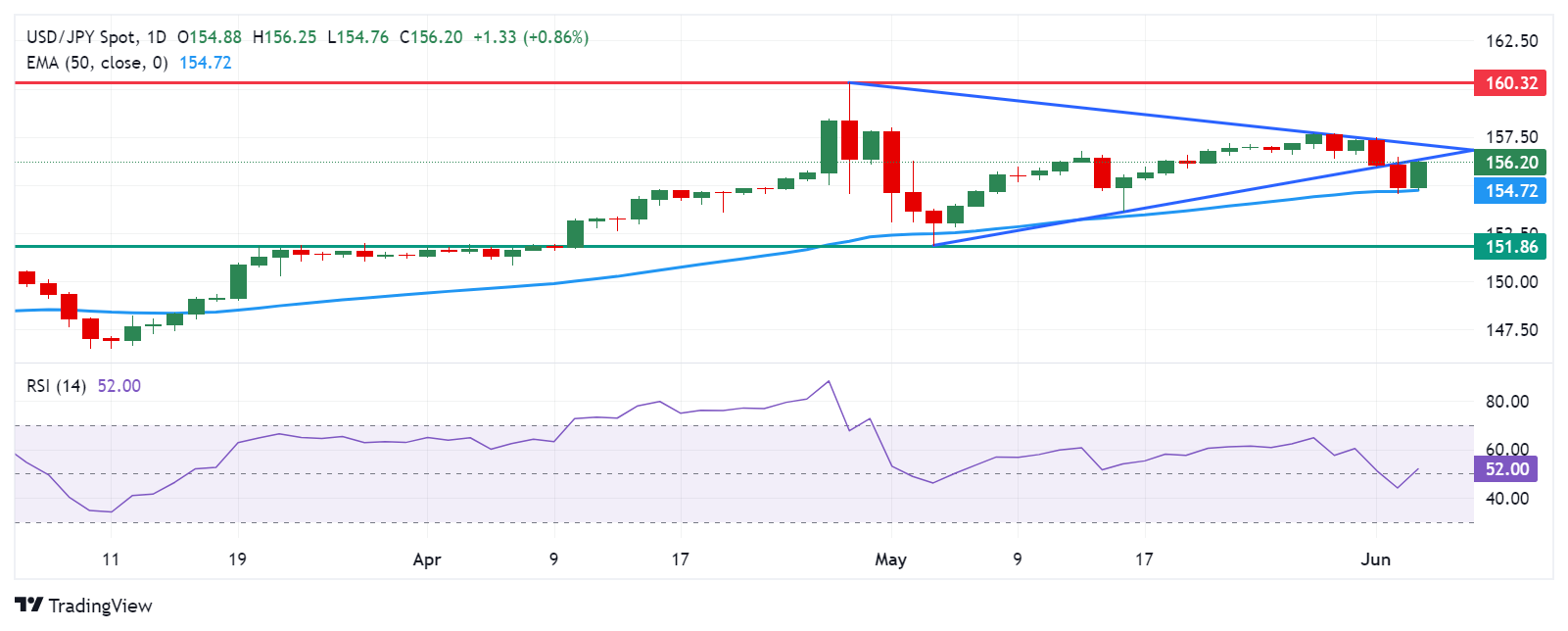- The Japanese Yen depreciates as investors adopt caution ahead of the US ADP Employment Change and ISM Services PMI.
- JPY could find support as Labor Cash Earnings surged by 2.1% YoY in April, marking the highest level since June last year.
- The US Dollar may struggle due to the rising possibility of the Fed implementing its first rate cut in September.
The Japanese Yen (JPY) edged lower on Wednesday due to investors' caution ahead of key US data releases later in the day, including the US ADP Employment Change and ISM Services PMI reports. Attention is expected to shift toward the Nonfarm Payrolls (NFP) report, which is due on Friday.
The Japanese Yen could face further downward pressure due to the interest rate differential between the United States (US) and Japan, which supports the USD/JPY pair. However, the upside potential of the USD/JPY pair may be limited by higher-than-expected data from Japan released on Wednesday.
The Jibun Bank Japan Services PMI was revised higher to 53.8 in May from the previous figure of 53.6. Despite the upward revision, it fell short of April's 8-month peak of 54.3, indicating the softest growth in the service sector since February. Additionally, Labor Cash Earnings surged by 2.1% year-on-year in April, surpassing forecasts for a 1.7% gain. This latest figure also marked the highest level since June last year.
The US Dollar Index (DXY), which gauges the value of the US Dollar (USD) against six other major currencies, has edged higher due to the improvement in US Treasury yields. However, the weaker US Manufacturing PMI in May has raised the possibility of the US Federal Reserve (Fed) implementing its first rate cut in September.
Traders are now pricing in nearly 64.9% odds of a Fed rate cut of at least 25 basis points, up from 46.3% a week earlier, according to the CME FedWatch Tool.
Daily Digest Market Movers: Japanese Yen depreciates due to risk-off mood
- The JOLTS US Job Openings declined by 296,000 to 8.059 million in April, down from March's 8.355 million, marking the lowest level since February 2021. This figure also missed the market consensus of 8.340 million, data showed on Tuesday.
- Bank of Japan (BoJ) Governor Kazuo Ueda said on Tuesday that the central bank will conduct "nimble" market operations if long-term interest rates spike, signaling the BoJ's readiness to ramp up bond buying when necessary. Ueda also stated that the BoJ will adjust the degree of monetary support if underlying inflation accelerates in line with its forecast, per Reuters.
- Reuters also reported that Japan's government will highlight the challenges a weak Yen poses for households in this year's long-term economic policy roadmap. This focus on the Yen's impact is expected to maintain pressure on the Bank of Japan to either raise interest rates or reduce its extensive bond-buying program.
- The ISM Manufacturing PMI unexpectedly dropped to 48.7 in May, down from April's reading of 49.2 and below the forecast of 49.6. The US manufacturing sector experienced its second consecutive month of contraction.
- Reuters reported on Monday that Japanese Economy Minister Yoshitaka Shindo announced that the government will “continue efforts for primary balance to reach within surplus territory in FY 2025.” Shindo also expressed optimism, stating that “Real economic growth of 1.3% in FY 2025 is not so unrealistic.”
- Last week, Atlanta Fed President Raphael Bostic stated in an interview with Fox Business that he does not think additional rate increases are necessary to achieve the Fed's 2% annual inflation target. Furthermore, New York Fed President John Williams stated as per Reuters that inflation is currently too high but should start to decline in the second half of 2024. Williams believes that monetary policy action is not urgently needed.
Technical Analysis: USD/JPY rebounds to near 156.00
The USD/JPY pair traded around 156.20 on Wednesday. Analysis of the daily chart suggests a weakening bullish bias as the pair breaks below the lower boundary of the symmetrical triangle pattern. Additionally, the 14-day Relative Strength Index (RSI) is slightly below the 50 level, indicating a potential for further decline that may confirm a bearish bias.
Immediate support for the USD/JPY pair could be found at the psychological level of 156.00. Further support appears at the 50-day Exponential Moving Average (EMA) at 154.72. A break below the latter could increase pressure on the pair, potentially leading it toward the region around throwback support at 151.86.
On the upside, a key barrier is evident at the lower threshold of the symmetrical triangle. If the USD/JPY pair returns to the symmetrical triangle, it would reinforce the bullish bias and could lead the pair to test the upper boundary of the pattern. A break above the psychological barrier of 157.00 would support the pair in retesting 160.32, its highest level in over thirty years.
USD/JPY: Daily Chart
Japanese Yen price today
The table below shows the percentage change of the Japanese Yen (JPY) against listed major currencies today. Japanese Yen was the weakest against the New Zealand Dollar.
| USD | EUR | GBP | CAD | AUD | JPY | NZD | CHF | |
| USD | 0.07% | -0.01% | -0.02% | -0.15% | 0.71% | -0.26% | 0.26% | |
| EUR | -0.06% | -0.07% | -0.08% | -0.20% | 0.67% | -0.29% | 0.22% | |
| GBP | 0.02% | 0.07% | -0.01% | -0.13% | 0.74% | -0.23% | 0.29% | |
| CAD | 0.02% | 0.09% | 0.01% | -0.12% | 0.78% | -0.21% | 0.32% | |
| AUD | 0.15% | 0.20% | 0.13% | 0.13% | 0.88% | -0.11% | 0.42% | |
| JPY | -0.71% | -0.69% | -0.74% | -0.77% | -0.88% | -1.02% | -0.46% | |
| NZD | 0.26% | 0.30% | 0.24% | 0.23% | 0.10% | 0.96% | 0.52% | |
| CHF | -0.30% | -0.22% | -0.29% | -0.30% | -0.45% | 0.45% | -0.52% |
The heat map shows percentage changes of major currencies against each other. The base currency is picked from the left column, while the quote currency is picked from the top row. For example, if you pick the Euro from the left column and move along the horizontal line to the Japanese Yen, the percentage change displayed in the box will represent EUR (base)/JPY (quote).
Japanese Yen FAQs
The Japanese Yen (JPY) is one of the world’s most traded currencies. Its value is broadly determined by the performance of the Japanese economy, but more specifically by the Bank of Japan’s policy, the differential between Japanese and US bond yields, or risk sentiment among traders, among other factors.
One of the Bank of Japan’s mandates is currency control, so its moves are key for the Yen. The BoJ has directly intervened in currency markets sometimes, generally to lower the value of the Yen, although it refrains from doing it often due to political concerns of its main trading partners. The current BoJ ultra-loose monetary policy, based on massive stimulus to the economy, has caused the Yen to depreciate against its main currency peers. This process has exacerbated more recently due to an increasing policy divergence between the Bank of Japan and other main central banks, which have opted to increase interest rates sharply to fight decades-high levels of inflation.
The BoJ’s stance of sticking to ultra-loose monetary policy has led to a widening policy divergence with other central banks, particularly with the US Federal Reserve. This supports a widening of the differential between the 10-year US and Japanese bonds, which favors the US Dollar against the Japanese Yen.
The Japanese Yen is often seen as a safe-haven investment. This means that in times of market stress, investors are more likely to put their money in the Japanese currency due to its supposed reliability and stability. Turbulent times are likely to strengthen the Yen’s value against other currencies seen as more risky to invest in.
Information on these pages contains forward-looking statements that involve risks and uncertainties. Markets and instruments profiled on this page are for informational purposes only and should not in any way come across as a recommendation to buy or sell in these assets. You should do your own thorough research before making any investment decisions. FXStreet does not in any way guarantee that this information is free from mistakes, errors, or material misstatements. It also does not guarantee that this information is of a timely nature. Investing in Open Markets involves a great deal of risk, including the loss of all or a portion of your investment, as well as emotional distress. All risks, losses and costs associated with investing, including total loss of principal, are your responsibility. The views and opinions expressed in this article are those of the authors and do not necessarily reflect the official policy or position of FXStreet nor its advertisers. The author will not be held responsible for information that is found at the end of links posted on this page.
If not otherwise explicitly mentioned in the body of the article, at the time of writing, the author has no position in any stock mentioned in this article and no business relationship with any company mentioned. The author has not received compensation for writing this article, other than from FXStreet.
FXStreet and the author do not provide personalized recommendations. The author makes no representations as to the accuracy, completeness, or suitability of this information. FXStreet and the author will not be liable for any errors, omissions or any losses, injuries or damages arising from this information and its display or use. Errors and omissions excepted.
The author and FXStreet are not registered investment advisors and nothing in this article is intended to be investment advice.
Recommended content
Editors’ Picks

AUD/USD: Further recovery targets 0.6400
AUD/USD soared to three-day highs around 0.6180 on Wednesday, bouncing back from multi-year lows near 0.5900 as easing worries over US tariffs helped fuel the recovery.

EUR/USD: Next on the upside comes the YTD peaks
EUR/USD ended the day with modest loses, coming under renewed downside pressure after hitting tops near 1.1100 the figure on the back of the late bounce in the Greenback.

Gold remains bid, refocuses on $3,100
Prices of Gold now regain some balance and approach the $3,100 zone per troy ounce on Wednesday after President Trump announced a 90-day pause on reciprocal and 10% tariffs. FOMC Minutes pointed to further caution from officials.

Bitcoin, crypto prices pump as Trump pauses tariffs for 90 days
Bitcoin (BTC) and several top cryptocurrencies rallied on Wednesday after President Donald Trump announced the United States (US) would pause its reciprocal tariff on 75 countries following their failure to retaliate and the opening of negotiations with key government agencies.

Tariff rollercoaster continues as China slapped with 104% levies
The reaction in currencies has not been as predictable. The clear winners so far remain the safe-haven Japanese yen and Swiss franc, no surprises there, while the euro has also emerged as a quasi-safe-haven given its high liquid status.

The Best brokers to trade EUR/USD
SPONSORED Discover the top brokers for trading EUR/USD in 2025. Our list features brokers with competitive spreads, fast execution, and powerful platforms. Whether you're a beginner or an expert, find the right partner to navigate the dynamic Forex market.




